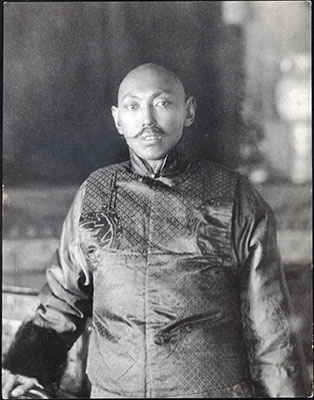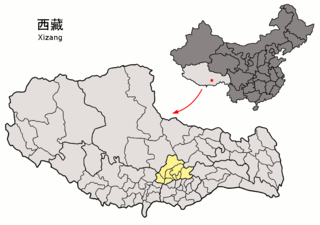Related Research Articles
Bar or BAR may refer to:

Tibet, or Greater Tibet, is a region in the central part of East Asia, covering much of the Tibetan Plateau and spanning about 2,500,000 km2 (970,000 sq mi). It is the homeland of the Tibetan people. Also resident on the plateau are some other ethnic groups such as the Monpa, Tamang, Qiang, Sherpa and Lhoba peoples and, since the 20th century, considerable numbers of Han Chinese and Hui settlers. Since the annexation of Tibet by the People's Republic of China in 1951, the entire plateau has been under the administration of the People's Republic of China. Tibet is divided administratively into the Tibet Autonomous Region, and parts of the Qinghai, Gansu, Yunnan and Sichuan provinces. Tibet is also constitutionally claimed by the Republic of China as the Tibet Area since 1912. Tibet is the highest region on Earth, with an average elevation of 4,380 m (14,000 ft). Located in the Himalayas, the highest elevation in Tibet is Mount Everest, Earth's highest mountain, rising 8,848.86 m (29,032 ft) above sea level.

Bhutan's early history is steeped in mythology and remains obscure. Some of the structures provide evidence that the region has been settled as early as 2000 BC. According to a legend it was ruled by a Cooch-Behar king, Sangaldip, around the 7th century BC, but not much is known prior to the introduction of Tibetan Buddhism in the 9th century, when turmoil in Tibet forced many monks to flee to Bhutan. In the 12th century, the Drukpa Kagyupa school was established and remains the dominant form of Buddhism in Bhutan today. The country's political history is intimately tied to its religious history and relations among the various monastic schools and monasteries.

The Tibet Autonomous Region, officially the Xizang Autonomous Region, often shortened to Tibet or Xizang, is an autonomous region of China and is part of Southwestern China.

The Panchen Lama is a tulku of the Gelug school of Tibetan Buddhism. The Panchen Lama is one of the most important figures in the Gelug tradition, with its spiritual authority second only to the Dalai Lama. Along with the council of high lamas, he is in charge of seeking out the next Dalai Lama. Panchen is a portmanteau of Pandita and Chenpo, meaning "great scholar".
An apostolic vicariate is a territorial jurisdiction of the Catholic Church under a titular bishop centered in missionary regions and countries where dioceses or parishes have not yet been established. The status of apostolic vicariate is often a promotion for a former apostolic prefecture, while either may have started out as a mission sui iuris. It is essentially provisional, though it may last for a century or more. The hope is that the region will generate sufficient numbers of Catholics for the Church to create a diocese one day.

Ngawang Namgyal (1594–1651), known colloquially as The Bearded Lama, was a Tibetan Buddhist Drukpa Kagyu school Rinpoche, and the unifier of Bhutan as a nation-state. He was later granted the honorific title Zhabdrung Rinpoche, approximately "at whose feet one submits"). In addition to unifying the various warring fiefdoms for the first time in the 1630s, he also sought to create a distinct Bhutanese cultural identity separate from the Tibetan culture from which it was derived.

Lobsang Trinley Lhündrub Chökyi Gyaltsen was the tenth Panchen Lama, officially the 10th Panchen Erdeni, of the Gelug school of Tibetan Buddhism. According to Tibetan Buddhism, Panchen Lamas are living emanations of the buddha Amitabha. He was often referred to simply as Choekyi Gyaltsen.
WTN may refer to:
This is a list of topics related to Tibet.
Rindü is a village and township in the Tibet Autonomous Region of China. It is under the jurisdiction of Namling County, Shigatse City in the Tibet Autonomous Region. It is located in the northwest of Nanmulin County.
The Golden Urn is a method for selecting Tibetan reincarnations by drawing lots or tally sticks from a Golden Urn introduced by the Qing dynasty of China in 1793. After the Sino-Nepalese War, the Qianlong Emperor promulgated the 29-Article Ordinance for the More Effective Governing of Tibet, which included regulations on the selection of lamas. The Golden Urn was introduced ostensibly to prevent cheating and corruption in the selection process but also to position the Qianlong Emperor as a religious authority capable of adducing incarnation candidates. A number of lamas, such as the 8th and 9th Panchen Lamas and the 10th Dalai Lama, were confirmed using the Golden Urn. In cases where the Golden Urn was not used, the amban was consulted. Golden Urn was exempted for Lhamo Dhondup to become the 14th Dalai Lama in 1940.
The serfdom in Tibet controversy is a prolonged public disagreement over the extent and nature of serfdom in Tibet prior to the annexation of Tibet into the People's Republic of China (PRC) in 1951. The debate is political in nature, with some arguing that the ultimate goal on the Chinese side is to legitimize Chinese control of the territory now known as the Tibet Autonomous Region or Xizang Autonomous Region, and others arguing that the ultimate goal on the Western side is to weaken or undermine the Chinese state. The argument is that Tibetan culture, government, and society were feudal in nature prior to the PRC takeover of Tibet and that this only changed due to PRC policy in the region. The pro-Tibetan independence movement argument is that this is a misrepresentation of history created as a political tool in order to justify the Sinicization of Tibet.

There were three main feudal social groups in Tibet prior to 1959, namely ordinary laypeople, lay nobility, and monks. The ordinary layperson could be further classified as a peasant farmer (shing-pa) or nomadic pastoralist (trokpa). To influence politics and religious domination, entering into monkhood and military was required. (Sunar). To trade of gold in Lhasa region of Tibet.

The Kashag was the governing council of Tibet during the rule of the Qing dynasty and post-Qing period until the 1950s. It was created in 1721, and set by Qianlong Emperor in 1751 for the Ganden Phodrang in the 13-Article Ordinance for the More Effective Governing of Tibet. In that year the Tibetan government was reorganized after the riots in Lhasa of the previous year. The civil administration was represented by the Council (Kashag) after the post of Desi was abolished by the Qing imperial court. The Qing imperial court wanted the 7th Dalai Lama to hold both religious and administrative rule, while strengthening the position of the High Commissioners.

The CIA Tibetan program was an anti-Chinese covert operation spanning almost twenty years. It consisted of "political action, propaganda, paramilitary and intelligence operations" facilitated by arrangements made with brothers of the 14th Dalai Lama, who himself was allegedly not initially aware of them. The stated goal of the program was "to keep the political concept of an autonomous Tibet alive within Tibet and among several foreign nations". The program was administrated by the CIA, and unofficially operated in coordination with domestic agencies such as the Department of State and the Department of Defense.

Tibet under Qing rule refers to the Qing dynasty's rule over Tibet from 1720 to 1912. The Qing rulers incorporated Tibet into the empire along with other Inner Asia territories, although the actual extent of the Qing dynasty's control over Tibet during this period has been the subject of political debate. The Qing called Tibet a fanbu, fanbang or fanshu, which has usually been translated as "vassal", "vassal state", or "borderlands", along with areas like Xinjiang and Mongolia. Like the preceding Yuan dynasty, the Manchus of the Qing dynasty exerted military and administrative control over Tibet, while granting it a degree of political autonomy.
Little Tibet is an Asian ethnic enclave within the neighbourhood of Parkdale in Toronto, Ontario, Canada. The area bound by Queen St. W. to the north, the Gardiner Expressway to the west and south, and Atlantic Avenue to the east is known for its many Tibetan émigrés and Tibetan-related businesses and restaurants. There is also a growing Tibetan community nearby in South Etobicoke but Little Tibet remains the largest.

This article documents the situation of the COVID-19 pandemic in the Tibet Autonomous Region.
References
- ↑ Summary of World Broadcasts: Asia, Pacific. British Broadcasting Corporation. 1999.
- ↑ Andy Zhang (April 2002). Hu Jintao: Facing China. iUniverse. pp. 89–. ISBN 978-0-595-22622-1.